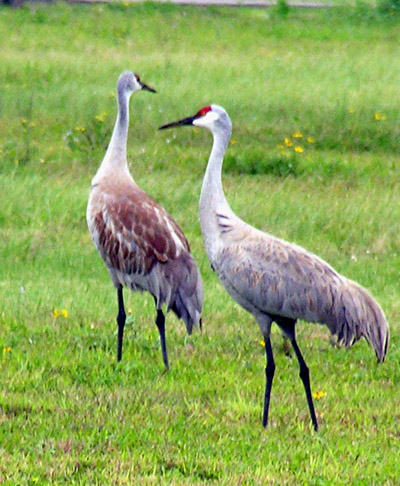By John Shackford
 There is a wild sound we sometimes hear in the spring in central Oklahoma that says so much about wildness. It is the high eerie call of the Sandhill Crane. Almost always the calls of a flock of cranes reach my ears well before I see the birds. It is always a pleasure to look for the flock to see where the calls are coming from. For me the calls are a reminder that there are still wild things that remain in our battered landscape.
There is a wild sound we sometimes hear in the spring in central Oklahoma that says so much about wildness. It is the high eerie call of the Sandhill Crane. Almost always the calls of a flock of cranes reach my ears well before I see the birds. It is always a pleasure to look for the flock to see where the calls are coming from. For me the calls are a reminder that there are still wild things that remain in our battered landscape.
Once, many years ago, in late winter or early spring, I was in the vicinity of Mustang, in the southwestern part of the metro area, when I heard and saw a large number of flocks of Sandhill Cranes heading south, instead of north. This, I believe was because a winter storm to the north was freezing water there, maybe at the Platte River, a major “staging” area for the cranes in Nebraska. Flock after flock of cranes were coming back south, and I was seldom out of hearing range of at least one flock for several hours.
I wondered if perhaps there was a crane “communication train” that passed the “word” flock to flock (via calls or sight) of bad conditions, perhaps frozen water, to the north. Each individual flock could be alerted down the line to turn around and seek open water to the south. Such a communication train could save a lot of extra calories for most of the crane flocks. And such a communication train could pass the word very swiftly all the way down the line—perhaps hundreds of miles.
On another occasion Warren Harden, Jack Tyler and I were in the Black Mesa area of Cimarron County, Oklahoma—in October I believe it was—and nearly all day long we were rarely out of hearing of at least one flock of cranes headed south. Many flocks landed at a pond about a mile and a half northwest of the Santa Fe Trail crossing sign along the main road to Kenton. They were apparently landing there to feed and spend the night. We saw birds feeding on the adjacent prairie, but could not tell what they were eating. By the time we drove by the area the next day, every crane was gone.
Warren Harden related to me information on Sandhill Crane pairing. Through radio-telemetry it has been found that the monogamous Sandhill Cranes have several patterns relating to their mates. Some Sandhill pairs stay together all the way from the breeding ground to the wintering grounds and back to the breeding grounds. Other separate along the way, perhaps at Platte River, spend the winter separated, return to the Platte River, there to find their mates—among 100,000 or so other cranes—and return to the breeding grounds. And some pairs separate shortly after leaving the breeding grounds, and only reunite shortly before reaching the breeding ground the following spring.
Listen for the cranes, and watch for “trains” of cranes—many migratory flocks following one another.
